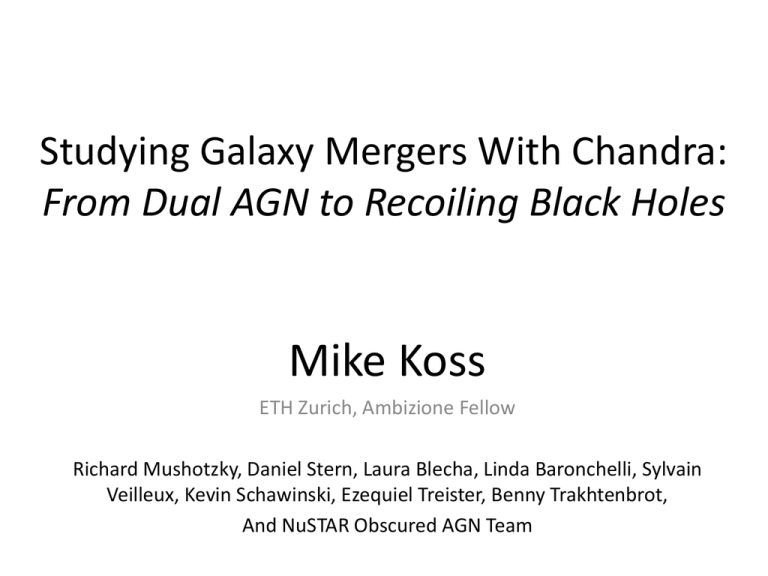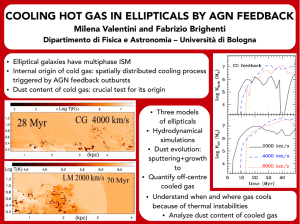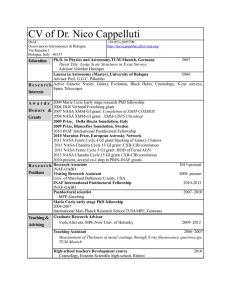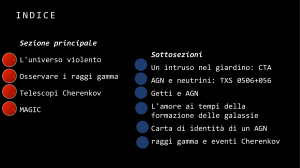Presentation - Chandra X
advertisement

Studying Galaxy Mergers With Chandra: From Dual AGN to Recoiling Black Holes Mike Koss ETH Zurich, Ambizione Fellow Richard Mushotzky, Daniel Stern, Laura Blecha, Linda Baronchelli, Sylvain Veilleux, Kevin Schawinski, Ezequiel Treister, Benny Trakhtenbrot, And NuSTAR Obscured AGN Team Studying Galaxy Merger Stages With Chandra Galaxy Merger Dual AGN Binary AGN BH Recoil Di Matteo et al 2005 1. How do Galaxy Mergers Grow BHs? – Measure Dual AGN fraction at different separations 2. Very Close dual AGN (<5 kpc)? – Exquisite PSF uncovers unknown dual AGN (e.g. Komossa et al. 2003) 3. Is there Evidence of Recoiling BHs? – Indirect Method to detect GW emission (e.g. Civano et al. 2012) Results from Simulations of Major Mergers Van Wassenhove et al. 2011. AGN activity is brightest at small scales (<10 kpc) Small scales have very short timescales Serendipitously Discovered Dual AGN (kpc scales) Dual AGN Galore, e.g. Komassa 03, Bianci 08, McGurk 11, Comerford 09) Relies on exquisite Chandra PSF (Koss et al. 2011) Interesting but… need systematic study to understand the effect of galaxy interactions on nuclear activities/BH growth! Let’s use Swift BAT all sky AGN… Dual AGN Study X-rays+Optical (16/167) Sample of Non-Detections <30 kpc Minor Mergers (>3 mass ratio) and absorption line galaxies (elliptical) Dual AGN Fraction with Separation Dual AGN Activity Increases at Smaller Separations More SMBH growth happens in the later stages of a merger process All close (<30 kpc), major merger, non elliptical systems are duals!!! X-ray luminosity (Chandra) increases dramatically at small separations (<10 kpc) Koss et al. 2012, ApJL 746,22 Accepted ALMA Observations of Duals 1) Gas rotation curves for each dual AGN pair are dominated by a simple rotation 2) Small scale inflow related to the merger or secular evolution such as bar-driven inflow 3) Estimate the rate of mass flowing to the nucleus based on residual velocities 1) Compare to the measured accretion rate from the X-rays for each AGN. Going to the Limits: Close Dual AGN (<1’’) Counts Image Smoothed (3 pixel) NGC 3393 (Fabbiano et al. 2011) 0.6’’ Separation Single source (NIR/Mid IR AO, HST, Radio) No tidal tails Source aligned with angle PSF hook artifact Not detected in other Chandra obs Counts Image Smoothed (3 pixel) SDSS J171544 (Comeford et al. 2011) 0.7’’ Separation Single source in NIR AO (Fu et al 2011) No tidal tails Source aligned with angle PSF hook artifact Not detected in other Chandra obs Could these duals be produced by smoothing a single PSF at 0.3’’? Seeing Double: Simulation of 1 PSF 6-7 keV PSF is worse (0.5’’, 50% ecf radius, 1.7’’ 90% ecf radius) Low count rate data (few counts per pixel) smooth Gaussian Smoothed scales much smaller than PSF (0.3’’) All NGC 3393 Observations 6-7 keV 1. Only 4868 and 12290 in original paper. 2. 3.1x deeper imaging from Grating Observations • No Evidence for secondary AGN 3. Only a few counts per pixels (Poisson) 4. Compare to Csmooth at 2.5 sigma • Differences are not statistically significant! Stacked Images Single Images Way Forward: Target Very Close Mergers in AO Hidden Mergers in Swift BAT Sample Keck Pilot Study of BAT AGN Compared to Inactive Galaxies: • 6/110 vs. 1/250 (Malkan et al. 2004, HST). Hidden mergers at 1-2 kpc are rare, but consider merger timescale Use merger information in observation • Align Chandra hook perpendicular Chandra and Recoiling Black Holes SDSS1133 in High Resolution SDSS 1133 Spectra Consistent with telescope PSF imaging, Kp (12 pc) From Hbeta, BH mass constant over a decade, Log MBH=6.2 Approved HST observations next fall of C IV line, recently brightened. Maximum Sensitivity for eLisa! Press Release NASA, ETH, Hawaii, Keck today. Perfect for Chandra observations because of small offset (5’’) Koss et al. 2014 Summary Dual AGN Activity 1. 2. 3. Chandra shows strong brightening at small separations Gas-rich, major mergers and avoids elliptical galaxies Matches Theoretical predictions in merger activity Close Duals (<1’’) and Recoiling Black Holes 1. Blind Chandra detection of duals is difficult • • 2. Avoid smoothing low count data on scales much smaller PSF Take advantage of multiwavelength data and simulations Many possibilities in nearby mergers and recoiling black holes Still Many Unanswered Questions Gas fueling ALMA+Chandra? Increase in dual AGN with redshift? NH with merger stage? Low Luminosity AGN duals? Rates of recoiling black holes? Bright Future for Chandra!!! Backup Historical Images Observed for 60+ years Makes Sne Unlikely Comparison to Other SNe 1. SDSS1133 would be the most luminous late time Halpha emission ever observed. Balmer Lines From Hbeta, BH mass stays constant over a decade Log MBH=6.0 (SDSS-2003), 6.0 (Keck 2013), 6.2 (2014). Maximum Sensitivity for eLisa! HST: UV spectra to look for broad CIV and other coronal lines. Has recently brightened by over a mag. Accepted! Press Release NASA, ETH, Hawaii, Keck Nov 21. Simulation of Dual AGN At 0.6’’, not well resolved, a real dual would be blended particularly since this ideal PSF doesn’t include PSF asymmetry like hook, blur from stacking. Zeroth Order Grating vs. Images No significant difference in PSF profile. SDSS171544 No Secondary Source in NIRC2 NGC 3393: Double Vision Test


